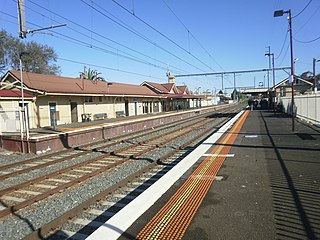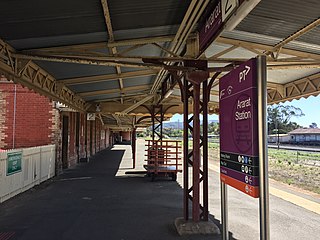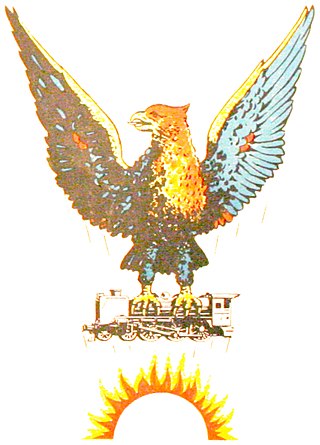
Mordialloc railway station is a commuter railway station on the Frankston line, which is part of the Melbourne railway network. It serves the south-eastern suburb of Mordialloc, in Melbourne, Victoria, Australia. Mordialloc station is a ground level unstaffed station, featuring two side platforms. It opened on 19 December 1881.

Ararat railway station is located on the Ararat and Western standard gauge lines in Victoria, Australia. It serves the town of Ararat, and opened on 7 April 1875.

The Wonthaggi railway line is a closed railway line located in South Gippsland, Victoria, Australia. Its primary purpose was to serve the State Coal Mine but the line also provided passenger and general goods services. The line was opened in 1910 and closed in 1978.

The R class was an express passenger steam locomotive that ran on Australia's Victorian Railways (VR) from 1951 to 1974. A long overdue replacement for the 1907-era A2 class 4-6-0, their development and construction was repeatedly delayed due to financial constraints caused by the Great Depression and later the manpower and materials shortages of World War II and the immediate postwar period.

The B class are a class of diesel locomotives built by Clyde Engineering, Granville for the Victorian Railways in 1952–1953. Ordered and operated by the Victorian Railways, they initiated the dieselisation of the system and saw use on both passenger and freight services, with many remaining in service today, both in preserved and revenue service. Some were rebuilt as the V/Line A class, while others have been scrapped.

The Newport Railway Workshops is a facility in the Melbourne suburb of Newport, Australia, that builds, maintains and refurbishes railway rollingstock. It is located between the Williamstown and Werribee railway lines.

Operation Phoenix was a post-World War II rehabilitation program carried out by the Victorian Railways (VR) in Australia. The program commenced in 1950 and was originally planned to take 10 years and cost £80 million pounds. Operation Phoenix was named after the bird from Egyptian mythology.
The 1922 Border Railways Acts, were Acts passed by the Parliaments of both Victoria and New South Wales, which authorised the construction of cross border railways in the Riverina region of Australia. Despite being located in New South Wales, the region was closer economically to Victoria and its railway network, operated by Victorian Railways. Another complication was that Victorian Railways used the 1,600 mm broad gauge, while the New South Wales Government Railways used 1,435 mm standard gauge.
Ballarat North Workshops is a railway engineering facility owned by Alstom in Ballarat, Victoria, Australia. It occupies 5.5 hectares of land beside the junction of the Mildura and Serviceton railway lines.
The Phoenix Foundry was a company that built steam locomotives and other industrial machinery in the city of Ballarat, Victoria, Australia. Over 30 years they built 352 locomotives for the Victorian Railways, of 38 different designs.
Bendigo Workshops is a railway workshop in Bendigo, Victoria, Australia. It is located in the north of the city beside the junction of the Yungera and Deniliquin railway lines. The site covers 10.3 hectares of land and has 31 separate buildings, including a 10,000 sqm main workshop building and six kilometres of railway track.

The Victorian Railways B class was a class of 2-4-0 passenger locomotives operated by the Victorian Railways (VR) between 1862 and 1917, built by various builders. The B class locomotives are regarded as the first mainline VR motive power, and were highly successful in passenger operations.

Jolimont Workshops was a railway workshop operated by the Victorian Railways beside Jolimont Yard, near the Melbourne CBD, Australia. Opened in 1917 and dedicated to the maintenance and repair of electric multiple units and locomotives, it was the first part of the yard to be closed and relocated, with demolition completed in 1994. The site is now part of the Melbourne Park tennis complex.

Jolimont Yard was an array of railway lines and carriage sidings on the edge of the central business district of Melbourne, Australia. Located between Flinders Street station, Richmond Junction, the Yarra River and Flinders Street they were often criticised for cutting off the city from the river, being the site of many redevelopment proposals. The Princes Gate Towers were built over part of the yard in the 1960s, which themselves were replaced by Federation Square in the 2000s. The rail sidings themselves were progressively removed from the 1980s to the 1990s with only running lines today, but the area continues to be referred to as the 'Jolimont railyards' by Melburnians.

The Victorian Railways E class was a class of electric locomotive that ran on the Victorian Railways (VR) from 1923 until 1984. Introduced shortly after the electrification of the suburban rail system in Melbourne, Australia, and based on the same electrical and traction equipment as Melbourne's early suburban electric multiple unit fleet, they provided power for suburban goods services and shunting for six decades.

The Williamstown Workshops was the first railway workshop operated by the Victorian Railways, located in the Melbourne inner western suburb of Williamstown.
The Victorian Railways V class of 1857 was a class of 0-6-0 goods locomotives operated by the Victorian Railways between 1858 and 1904, built by George England and Co., Newcastle upon Tyne, England.

The State Coal Mine, also known as State Coal Mine Heritage Area, is a former 20th-century state-owned black coal mine located in Wonthaggi, Victoria, Australia. The mine was operational from 1910 until 1968 and is now a state park and tourist attraction.

South Dynon Locomotive Depot is an Australian locomotive depot in Melbourne, purpose built for the servicing of diesel and electric locomotives by the Victorian Railways opening in July 1961.

The West Melbourne Swamp also known as Batman's Swamp, was a large saltwater wetland located to the west of the city of Melbourne, Victoria. It was an important resource for Aboriginal people.















